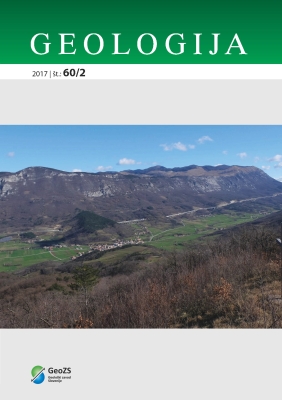Analysis of systematic fracturing in Eocene flysch of the Slovenian coastal region
DOI:
https://doi.org/10.5474/geologija.2017.014Abstract
We analyse systematic fractures occurring in sandstone beds in Eocene flysch of the Slovenian coastal area. Two nearly perpendicular fracture sets were identified: fractures F1 are generally NW-SE oriented, well-expressed and predominately planar, whereas fractures F2 are NE-SW-striking, shorter, more irregular in shape, and terminate against the F1 set. The average orientation of both sets does not change significantly in a coastal transect crossing all principal structural domains of the area. We analysed fracture spacing with respect to layer thickness and determined fracture spacing index for both fracture sets. We interpret both fracture sets as tensional (Mode I) joints originating in two distinct extensional episodes. Set F1 is older and formed in NE-SW directed tension which we correlate with the well-documented regional post-Dinaric orogen-perpendicular extension of presumably mid-Miocene age. Set F2 formed in NW-SE oriented tension, which is compatible with previously documented NE-SW-striking normal faults occurring in the area, but was so far not documented elsewhere. We interpret that F1 fractures predate folding and thrusting in the coastal belt. Earlier, Eocene-Oligocene Dinaric thrusting therefore did not significantly affect the coastal area, whereas post-F1 shortening, associated with northward indentation and underthrusting of the Adria microplate, did not commence before late Miocene.Downloads
How to Cite
Vrabec, M., & Jordanova, G. (2017). Analysis of systematic fracturing in Eocene flysch of the Slovenian coastal region. Geologija, 60(2), 199–210. https://doi.org/10.5474/geologija.2017.014
Issue
Section
Articles

